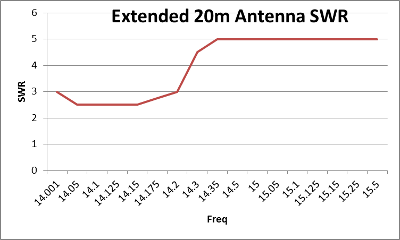
Even so I decided it was time to upgrade the antenna and make it multi-band so that I could use it with the new 20m radio that I am constructing. I picked a fan dipole. It's a compromise antenna, but it only requires one feedline and no antennna switch. Construction was simple. I calculated the lengths using a spreadsheet. For years I have used the following calculation based on the ARRL Antenna Handbook:
Calculate the wavelength in meters using center frequency divided by 299.7925
Divide by two to get a half wave
Multiply by 0.95 because of end effects (capacitance of the insulator/rope at each end)
Multiply by 0.97 for insulated wire
Divide by two to get the length of one half (which is what I actually cut)
Add 15cm to allow connection to the center and connection to the end insulator
The calculation above gave me 9.902m for 7.1MHz and 5.049m for 14.2Mhz.
At this point I got confused I think. My fan dipole would be in an inverted vee configuration. There would also be some interation between the dipoles. I wanted to cut the dipoles a little bit too long, so that I could trim to length. The ARRL Antenna handbook said that that an inverted vee has a slightly higher resonant frequency. Articles on the internet said that an inverted vee will be shorter than a standard dipole, so I would be able to trim it to length. I didn't spot that these two statements were not in agreement. If you shorten a dipole you raise its resonance further. I cut the wires to the lengths for a standard dipole thinking I could trim them down to minimum SWR. I connected them together as a fan dipole and suspended them from a fiberglass mast on the roof. With everything clear of the structure its should not be impacted by the weather. I measured the SWR with an antenna analyzer. The 20m dipole was not good, as shown in the first graph.

Analysis of the antenna showed that it was resonant above the 20m band, just as the ARRL Antenna Handbook said it would be. A quick calculation indicated that I would need to lengthen it by 6% to make it resonant at 14.2MHz. I added 30cm to each end and measured again.

Changing the length of the 20m inverted vee did not change the SWR of the 40m inverted vee even though they were connected together as a fan dipole.
Enter Comments Here:
| On: 01/01/14 10:10 DE VU3TAH, TAHA said: |
| put both ANT like a cross(+) not one below one...! |
| On: 01/06/14 10:10 G0KLA, Chris said: |
| Yes, I know that makes more sense. There is not enough room on the roof for that though. The building is quite narrow and the antenna is on one side. I don't have room for one antenna to be at 90 degrees to the other. Thanks for the thought though. |
| On: 03/01/17 5:05 G4CIZ said: |
| I have a fan inverted V 80m and 40m dipole of the same feedpoint. My 40m antenna ended up being 2ft longer then the inverted V formula. I came to the conclusion that the presence of the 80m dipole raised the resonant frequency of the 40m one. |
| On: 03/01/17 15:15 G0KLA, Chris said: |
| Sounds good. Glad that worked out. I have since removed my 20m fan dipole and replaced it with a 20m vertical. So in effect I have followed Taha's advice and put the antennas in a cross(+) only one is horizontal and the other vertical. I managed to fit that on the roof! The 20m vertical is a quarter wave and on the other side of the roof. It has two radials, which seems to work well given it is over 10m above the ground. |
Copyright 2001-2021 Chris Thompson
Send me an email